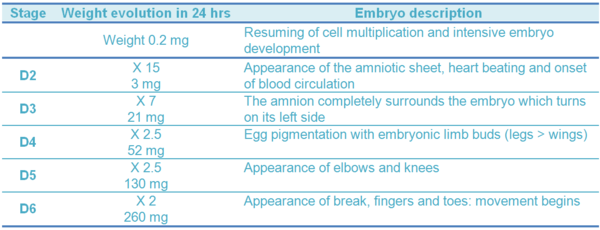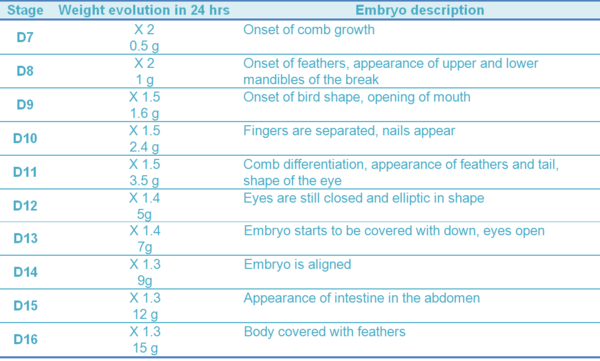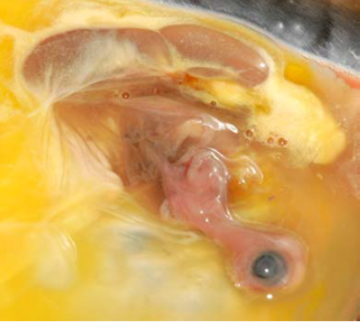...
--> Introduction
--> The different stages of embryonic development
--> Conclusion
...
EMBRYONIC DEVELOPMENT
By Dr Stephan WARIN, DVM, Avian Business Unit.
CEVA Santé Animale, La Ballastiere, BP 126, 33501 Libourne Cedex, France
.
INTRODUCTION
The purpose of this article is to teach the reader how to recognize good incubating eggs from poor incubating eggs on the one hand and, when opening an egg, to determine its development stage and the date of a potential problem, on the other hand.
Thorough knowledge of embryonic development is an aid in understanding the requirements for the good development of the future chick and the reasons why some incubation phases are crucial.
Such knowledge is also the basis for embryo-diagnosis, which helps to determine the age and cause of death of the embryo with the aim to remedy this phenomenon and improve hatcheries’ performances.
.
THE DIFFERENT STAGES OF EMBRYONIC DEVELOPMENT
Total embryonic development times are 21 days for chickens, 27-28 days for common ducks, turkeys and guinea fowls, 29-30 days for geese, 31-32 days for mulard ducks and 34-35 days for muscovy ducks.
The following data applies to the hen species.
Once the embryo has been fertilized (1st day), embryogenesis begins and will last for 5 days, after which the embryo essentially grows until hatching. During the last 3 days, organs develop and the chick enters its maturation phase.
^ Top page
.
A. Embryo Differentiation (1-6 days)
As seen earlier, the encounter between the ovum and sperms takes place in the portion of the oviduct called the magnum approximately three hours after ovulation.
The egg cools down when in contact with the outer environment and embryonic development stops as long as the egg’s temperature is below 25°C (the physiological zero of incubation). Development will only resume in optimal conditions after raising temperature to 37.8°C.
1. From fertilization to oviposition
The first cell division occurs when the egg is in the isthmus (it starts approximately 3 hours after ovulation) and continues throughout its descent toward the reproductive tract.
Six to eight hours prior to oviposition, two distinct zones on the yolk surface can be seen with the naked eye: the area pellucida (translucent) in the center and the surrounding area opaca (early blastula stage). At this stage, the symmetry axis of the future embryo is determined by the coiling of chalazae during egg shell formation.
The late blastula stage (50.000 cells delimiting two superimposed cavities) is reached shortly before oviposition.
Embryonic development then remains at this stage as long as temperature is kept under 21°C-22°C.
2. Embryo formation
After 5-6 hours of incubation, thickening of the rear portion of the area pellucida occurs.
After 16 hours, thickening extends along the entire length of the blastoderm and forms the primitive streak.
At 18 hours, the cephalic extension can be seen, gastrulation is completed and neurulation begins.
After 20 hours, the primitive streak shrinks while differentiation begins: cephalic folding, individualization of somites.
After 40 hours, the brain and heart are formed, and the anterior intestine takes shape. The embryo lifts up over the yolk and lies on its left side. The first heart beats occur (40/min.) and permit blood circulation between the embryo and the egg yolk.
^ Top page
.
B. Organ Development (7-17 days)
^ Top page
.
C. Maturation and Preparation for Hatching (18-21 days)
^ Top page
.
D. Critical development phases
The embryo is particularly fragile at the following phases of incubation:
- First 2 days: risk of early mortality due to blastoderm fragility when embryonic development resumes, and structuring of vascular network. The transformation of the blastoderm into a basic embryo occurs during the first 2 days of incubation and during this time the embryo is at its most vulnerable to disturbances. Many of the abnormalities seen in late embryos or hatchling have their origins in mishaps at these early stages.
- Around 5-6 days: the yolk vesicle completes its development, the vitelline membrane disappears and the allantois starts to function as a respiratory organ --> particular susceptibility to shocks.
- At the end of incubation (18-19 days): coming into service of the definitive kidney, organization of aerial respiration.
- At hatching: pipping difficulties resulting in mortality due to exhaustion–at hatching or shortly thereafter–respiratory failure, inadequate resorption of the yolk vesicle (due to excessive temperature causing an increase in organ volume, thereby hampering yolk retraction).
Risks of malformation are high, especially during the first 6 days of incubation, when organs differentiate. Afterwards, organs grow in volume: any abnormality during this phase results rather in a change (extension or shortening) in embryonic development duration.
In the chicken, the association of embryonic mortality with embryo age is approximately as follows:
- 0-4 days: 25%
- 4-16 days: 10%
- 16-21 days: 65%
Example: embryo mortality at day 9.
^ Top page
.
CONCLUSION
Better understanding critical embryo development phases and recognize them is of paramount importance to diagnose at which period mortality occurs. Embryodiagnostic should be a common daily examination. The two more sensitive incubation phases are the onset of blood circulation (first week) and onset of lung breathing (last five days). This leads to investigate which parameter is incorrect (atmosphere composition, temperature, humidity, egg turn over…) and try to find a solution.
^ Top page
If you need to download this article, please do not hesitate to contact us!

 Corporate Website
Corporate Website
 Africa
Africa
 Argentina
Argentina
 Asia
Asia
 Australia
Australia
 Belgium
Belgium
 Brazil
Brazil
 Bulgaria
Bulgaria
 Canada (EN)
Canada (EN)
 Chile
Chile
 China
China
 Colombia
Colombia
 Denmark
Denmark
 Egypt
Egypt
 France
France
 Germany
Germany
 Greece
Greece
 Hungary
Hungary
 Indonesia
Indonesia
 Italia
Italia
 India
India
 Japan
Japan
 Korea
Korea
 Malaysia
Malaysia
 Mexico
Mexico
 Middle East
Middle East
 Netherlands
Netherlands
 Peru
Peru
 Philippines
Philippines
 Poland
Poland
 Portugal
Portugal
 Romania
Romania
 Russia
Russia
 South Africa
South Africa
 Spain
Spain
 Sweden
Sweden
 Thailand
Thailand
 Tunisia
Tunisia
 Turkey
Turkey
 Ukraine
Ukraine
 United Kingdom
United Kingdom
 USA
USA
 Vietnam
Vietnam








